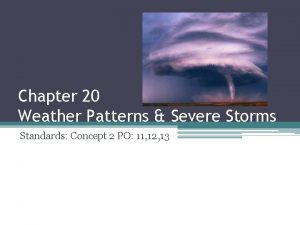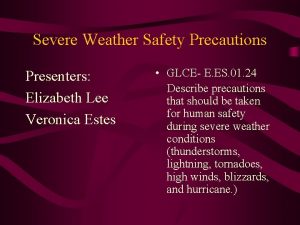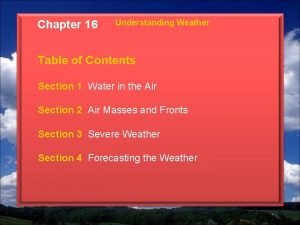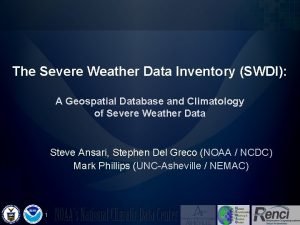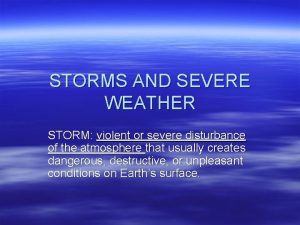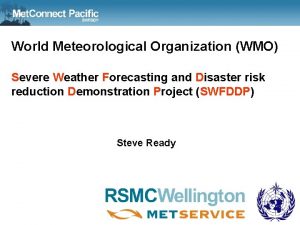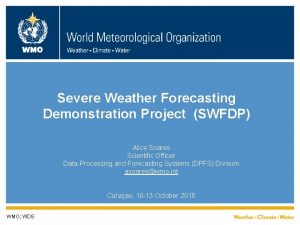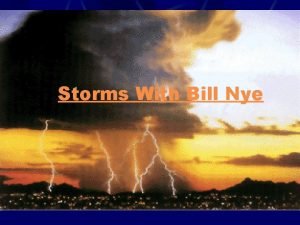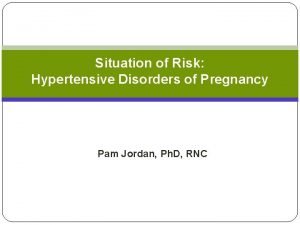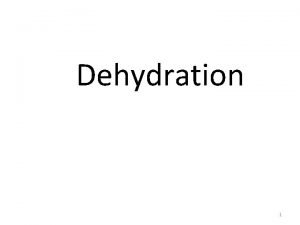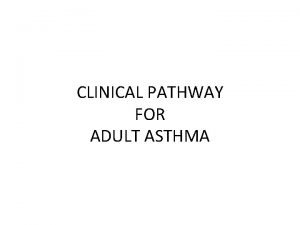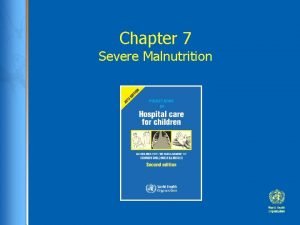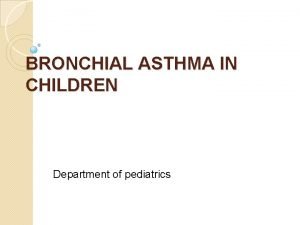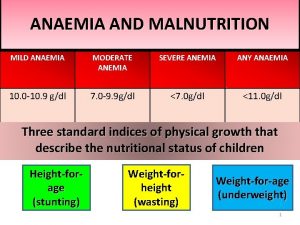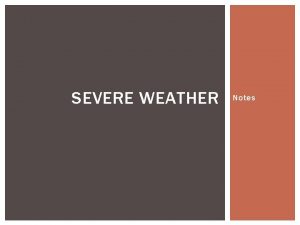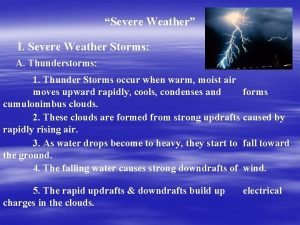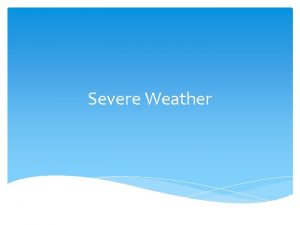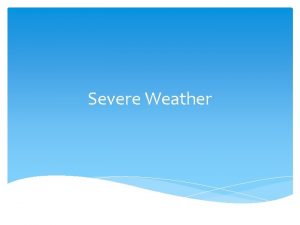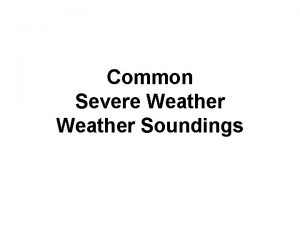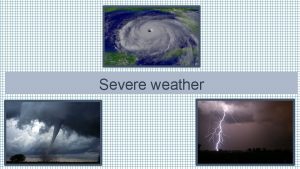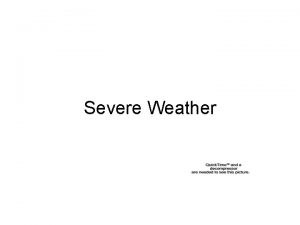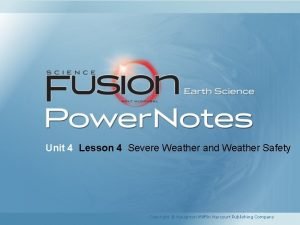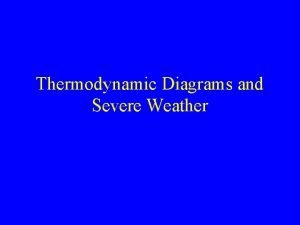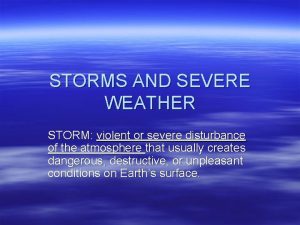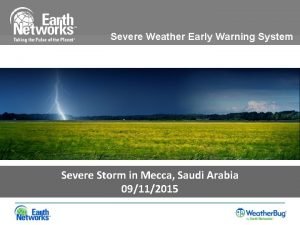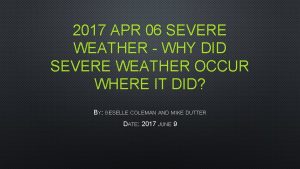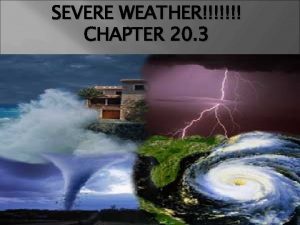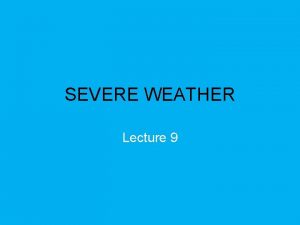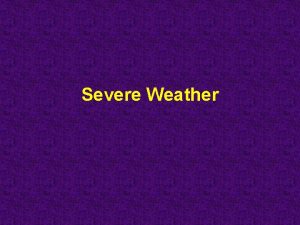Unit 4 Lesson 4 Severe Weather and Weather


























- Slides: 26

Unit 4 Lesson 4 Severe Weather and Weather Safety

Unit 4 Lesson 4 Severe Weather and Weather Safety Take Cover! What do we know about thunderstorms? • A thunderstorm is an intense local storm that forms strong winds, heavy rain, lightning, thunder, and sometimes hail. • Thunderstorms are a type of severe weather. Severe weather can cause property damage and sometimes death. • There are three basic stages to a thunderstorm.

Unit 4 Lesson 4 Severe Weather and Weather Safety What do we know about thunderstorms? • Stage 1 – Warm humid air rises in an updraft, creating cumulus clouds.

Unit 4 Lesson 4 Severe Weather and Weather Safety What do we know about thunderstorms? • Stage 2 – Ice particles may form at the top of the cloud. They fall and pull cold air down, creating a downdraft and heavy rain or hail.


Unit 4 Lesson 4 Severe Weather and Weather Safety What do we know about thunderstorms? • Stage 3 – The storm slows or ends as the downdraft prevents more warm air from rising.

Unit 4 Lesson 4 Severe Weather and Weather Safety What do we know about thunderstorms? • Lightning is an electric discharge that happens between positively and negatively charged areas. • Electrical charges build up near the tops and bottoms of clouds as pellets of ice move up and down through the clouds. • The stepped leader is the first part of the strike process. A stepped leader comes from the cloud to make contact with an opposite charge. As the stepped leaders approach the surface, objects on the surface begin responding to the strong electric field. The objects reach out to the cloud by "growing" positive streamers. When the two meet, the streamer returns to the cloud and the return stroke is what we see (the big flash). All of this is done in about half a second! • Thunder is the sound created by the rapid expansion of air along a lightning strike.

Stepped leader Positive streamer


Unit 4 Lesson 4 Severe Weather and Weather Safety Plan Ahead! What do we know about hurricanes? • A hurricane is a tropical low-pressure system with winds blowing at speeds of 119 km/h (74 mph) or more. • Hurricanes form from thunderstorms fueled by the evaporation of warm ocean water. • Winds spiral around the low-pressure center of a hurricane.


Unit 4 Lesson 4 Severe Weather and Weather Safety What do we know about hurricanes? • High winds and tornadoes can result from hurricanes and cause massive damage. • A storm surge is a huge mass of ocean water that gets pushed onto coastal areas, causing sea levels to rise several meters. • Damages can take months to clean up.


Unit 4 Lesson 4 Severe Weather and Weather Safety Secure Loose Objects! What do we know about tornadoes? • A tornado is a destructive, rotating column of air with very high wind speeds that is often visible as a funnel-shaped cloud. • Horizontal winds at high altitudes can cause a thunderstorm to spin and create a tornado.


Unit 4 Lesson 4 Severe Weather and Weather Safety What do we know about tornadoes? • Tornado Alley is the location in the Midwest where tornadoes are common. • Tornadoes often occur in the spring and early summer. • Winds may reach speeds of over 400 km/h.


Unit 4 Lesson 4 Severe Weather and Weather Safety Be Prepared! What can people do to prepare for severe weather? • Severe weather can cause property damage, injury, and sometimes death. • Hail, lightning, high winds, tornadoes, hurricanes, and floods are all severe weather events.

Unit 4 Lesson 4 Severe Weather and Weather Safety What can people do to prepare for severe weather? • Plan ahead by creating a storm supply kit that contains essential safety items. • Listen to the radio or TV for storm updates such as watches and warnings of upcoming storms.

Unit 4 Lesson 4 Severe Weather and Weather Safety What can people do to prepare for severe weather? • A watch is given when conditions are ideal for severe weather. • A warning is given when severe weather has been spotted or is expected within 24 hours. • Follow flood safety rules by getting to higher ground and staying out of floodwaters.

Unit 4 Lesson 4 Severe Weather and Weather Safety What can people do to stay safe during a thunderstorm? • Seek shelter if you hear thunder. Stay away from tall buildings and trees. • Stay away from ponds, lakes, and bodies of water. • Avoid using electrical appliances, phones, and running water when indoors.

Unit 4 Lesson 4 Severe Weather and Weather Safety How can people stay safe during a tornado? • Go to a place without windows, such as a basement, storm cellar, or closet. • Avoid areas where flying objects may cause harm. • If you are outside, lie in a ditch or low-lying area and protect your head with your arms and hands.

Unit 4 Lesson 4 Severe Weather and Weather Safety How can people stay safe during a hurricane? • Have a plan to leave the area and listen for storm updates. • Secure loose objects and prepare your home. • If told to evacuate, do so immediately.

Unit 4 Lesson 4 Severe Weather and Weather Safety Use Sun Sense! How can people protect their skin from the sun? • Melanin in the skin can help protect against ultraviolet (UV) radiation from the sun. • Protect your skin from sunburn, even on cloudy days. • Prevent sunburn by wearing sunscreen with a sun protection factor (SPF) of 30 or more.

Unit 4 Lesson 4 Severe Weather and Weather Safety How can people protect themselves from summer heat? • Heat exhaustion occurs when the body has been exposed to high temperatures for too long. • Signs and symptoms of heat exhaustion may develop suddenly or over time, especially with prolonged periods of exercise. Possible heat exhaustion signs and symptoms include: Cool, moist skin with goose bumps when in the heat. Low blood pressure upon standing Heavy sweating Muscle cramps Faintness Nausea Dizziness Headache Fatigue Weak, rapid pulse

Unit 4 Lesson 4 Severe Weather and Weather Safety How can people protect themselves from summer heat? • Heat stroke occurs when the body loses its ability to cool itself by sweating. It is life threatening. Possible heat exhaustion signs and symptoms include: high body temperature loss of consciousness rapid pulse hot, dry skin shallow breathing Fatigue disorientation • Heat stroke victims need emergency help. • Limiting outdoor activities in hot and humid weather and drinking lots of water can help prevent heat illnesses.
 Chapter 20 weather patterns and severe storms
Chapter 20 weather patterns and severe storms Chapter 20 weather patterns and severe storms
Chapter 20 weather patterns and severe storms Severe weather safety precautions worksheet
Severe weather safety precautions worksheet Chapter 16 section 3 severe weather answer key
Chapter 16 section 3 severe weather answer key Severe weather data inventory
Severe weather data inventory Severe weather graphic organizer
Severe weather graphic organizer Wmo severe weather
Wmo severe weather Swfdp
Swfdp Cumulus mature dissipating
Cumulus mature dissipating Weather forecasts lesson 3 outline answers
Weather forecasts lesson 3 outline answers Right triangle trigonometry examples
Right triangle trigonometry examples Unit 10, unit 10 review tests, unit 10 general test
Unit 10, unit 10 review tests, unit 10 general test Exclamation mark pictogram whmis
Exclamation mark pictogram whmis Magnesium sulfate toxicity level
Magnesium sulfate toxicity level None mild moderate severe
None mild moderate severe Dr sofi
Dr sofi Hypocalcemia causes
Hypocalcemia causes Signs of hypocalcemia
Signs of hypocalcemia Types of dehydration
Types of dehydration Hypertonic dehydration
Hypertonic dehydration Asthma clinical pathway
Asthma clinical pathway Malnutrition case presentation
Malnutrition case presentation Pef in asthma
Pef in asthma Mild moderate severe asthma exacerbation
Mild moderate severe asthma exacerbation Severe anemia
Severe anemia What is life
What is life Severe ms heart
Severe ms heart

